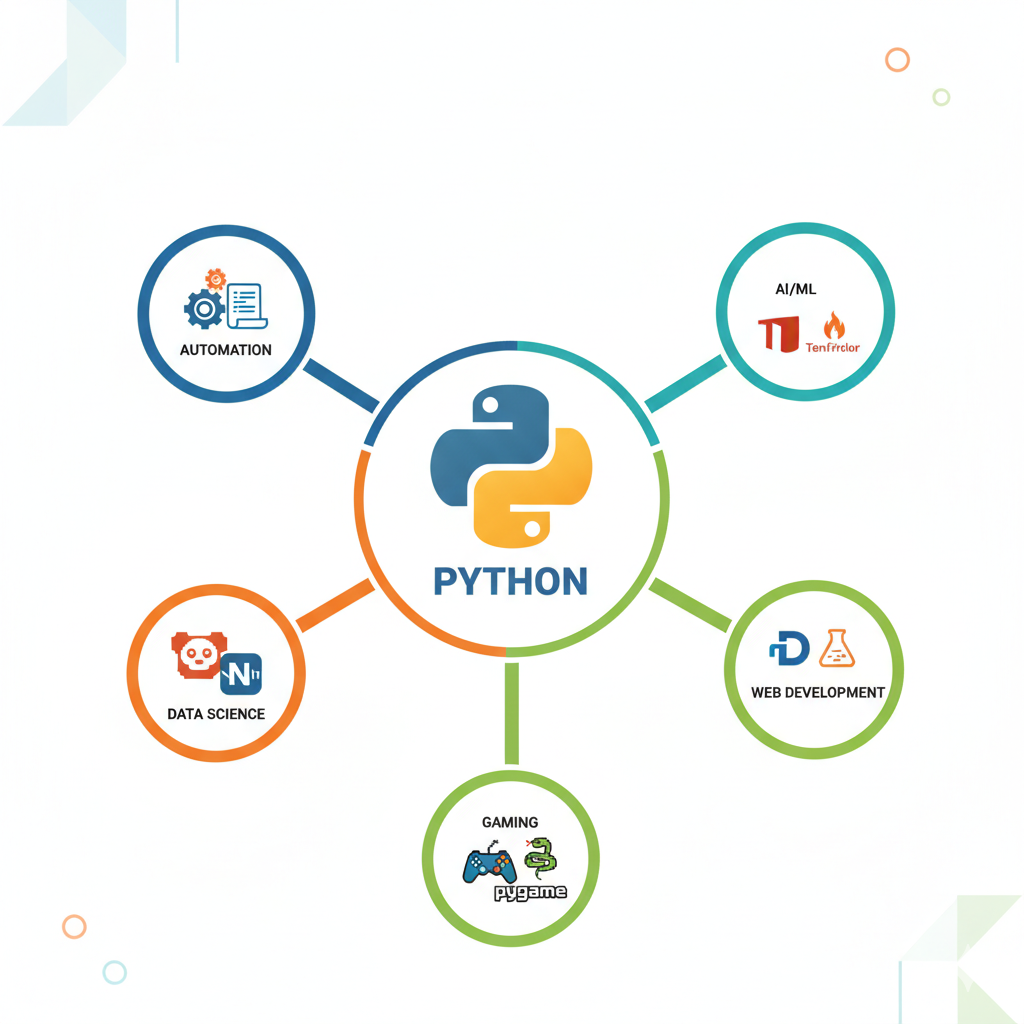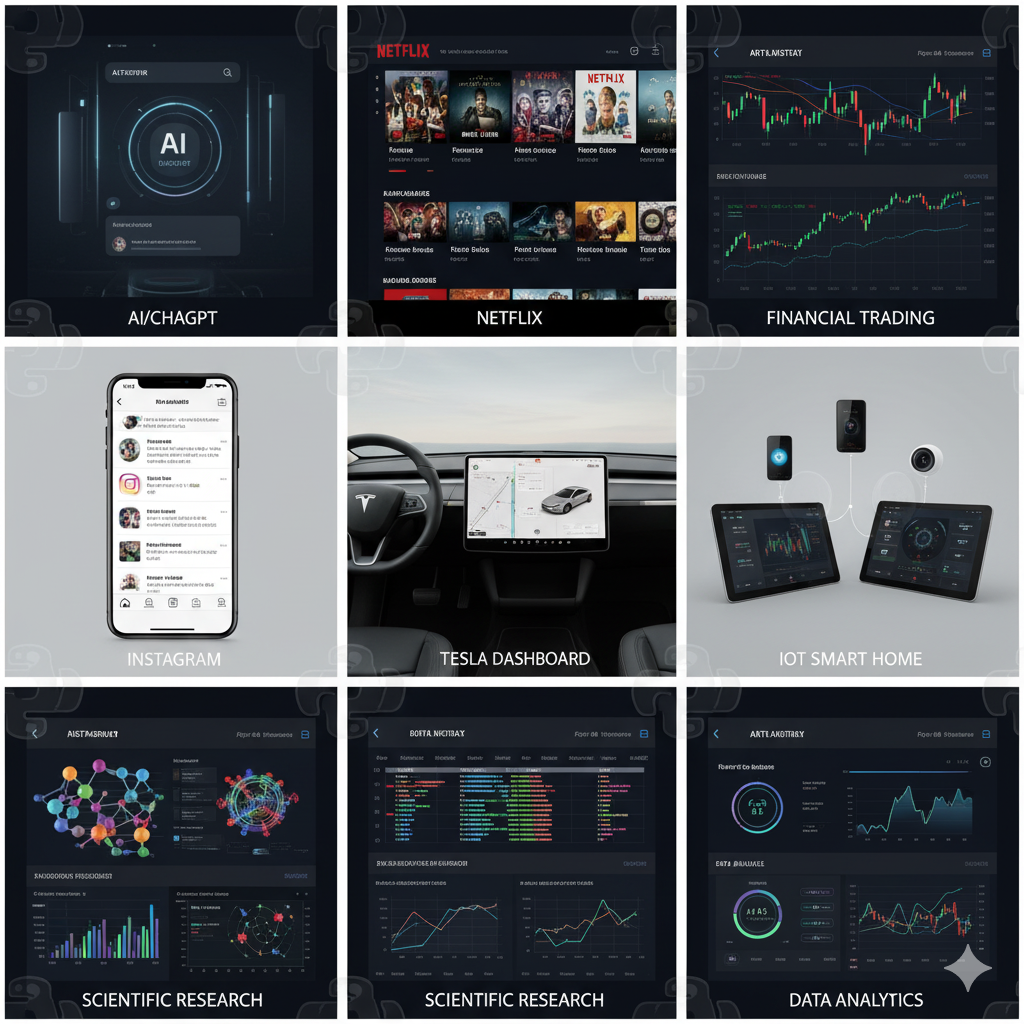
Reading Time: 11 mins

TL;DR: Python dominates 2025 with 23% market share, powering AI breakthroughs, web applications, data science projects, and automation tools. From ChatGPT to Netflix’s recommendation engine, Python’s versatility makes it the #1 choice for developers across industries—and the perfect starting language for aspiring programmers.
Python has evolved from a simple scripting language to the backbone of modern technology. Whether you’re watching Netflix recommendations, using ChatGPT, or browsing Instagram, Python powers the digital experiences that shape our daily lives. According to the latest 2025 data, Python maintains a dominant 23.28% rating on the TIOBE Index and is used by 57% of developers globally, making it the world’s most popular programming language.
But what exactly is Python used for, and why do tech giants like Google, Netflix, and Tesla choose it for their most critical applications? This comprehensive guide explores Python’s real-world applications, from artificial intelligence to web development, showing you why learning Python in 2025 isn’t just smart—it’s essential.
Python isn’t just another programming language—it’s a philosophy of simplicity and readability that has revolutionized how we build software. Created by Guido van Rossum in 1991, Python was designed with one core principle: code should be as readable as English.
Simplicity That Scales: Python’s clean syntax allows developers to express complex ideas in fewer lines of code. While other languages might require 20 lines for a simple task, Python often accomplishes the same in just 5-6 lines.
Cross-Platform Compatibility: Whether you’re working on Windows, macOS, or Linux, Python code runs everywhere without modification. This cross-platform nature has been crucial for Python’s adoption across diverse development environments.
Massive Ecosystem: Python’s Package Index (PyPI) hosts over 85,000 modules, providing pre-built solutions for virtually any programming challenge you can imagine.
Beginner-Friendly Yet Powerful: Python serves as an excellent introduction to programming for kids while remaining sophisticated enough for enterprise applications at companies like Google and NASA.
41% of Python developers use the language specifically for machine learning in 2025, making it the undisputed leader in AI development. Python’s dominance in this field isn’t accidental—it’s the result of powerful libraries and frameworks that make complex AI accessible.
Real-World Examples:
Key Python AI Libraries:
Why Python Excels in AI: Python’s readable syntax allows data scientists to focus on solving problems rather than wrestling with complex code. Python offers support at every stage of the AI process, from prototyping to production, and integrates into MLOps pipelines with minimal friction.
Python’s web development capabilities power some of the world’s most-visited websites. From rapid prototyping to enterprise-scale applications, Python frameworks provide the foundation for secure, scalable web solutions.
Major Websites Built with Python:
Popular Python Web Frameworks:
Python’s compatibility with machine learning libraries allows developers to incorporate predictive analytics and AI-powered features into web applications, creating intelligent web experiences that adapt to user behavior.
In 2025, data drives every major business decision, and Python serves as the primary tool for extracting insights from complex datasets. 51% of Python developers are involved in data exploration and processing, making it the lingua franca of data science.
Data Science Applications:
Essential Data Science Libraries:
Python excels at eliminating repetitive tasks through intelligent automation. Python scripts automate repetitive tasks, from testing and deployment to cloud orchestration, making it a key part of DevOps pipelines.
Automation Use Cases:
Popular Automation Libraries:
Python enables rapid development of cross-platform desktop applications with native look and feel. While not as common as web development, Python desktop apps serve specific niches effectively.
Notable Python Desktop Applications:
Desktop Development Frameworks:
While Python isn’t typically used for AAA game development due to performance constraints, it excels in several gaming contexts and has powered successful commercial games.
Python in Gaming:
Game Development Libraries:
For aspiring young developers, Python offers an excellent introduction to game programming concepts. Check out our guide on how to make a Flappy Bird game on Scratch to start building games with visual programming before moving to Python.
Python has become the standard language for scientific research across disciplines, from physics and chemistry to biology and astronomy.
Scientific Applications:
Scientific Python Libraries:
Python’s versatility makes it invaluable for cybersecurity professionals who need to quickly develop custom tools and analyze security threats.
Cybersecurity Applications:
Security-Focused Libraries:
Python’s ability to be used for microcontroller programming with tools like MicroPython has made it a key player in IoT device management. From smart homes to industrial automation, Python bridges the gap between software and hardware.
IoT Applications:
IoT Python Tools:
In finance, Python powers predictive risk models and fraud detection systems, transforming how institutions manage data. The language’s mathematical capabilities and real-time processing make it ideal for financial applications.
FinTech Applications:
Financial Python Libraries:
Python’s readability makes it an ideal teaching language, and many educational platforms are built using Python frameworks. The language serves both as a learning tool and a platform for building educational technology.
Educational Applications:
At ItsMyBot, we leverage Python’s educational potential in our coding programs for kids, helping young learners transition from visual programming to text-based coding naturally.
Python’s scalability and maintainability make it excellent for enterprise applications and modern microservices architectures.
Enterprise Use Cases:
Enterprise Python Frameworks:

Rapid Development Cycles: Python’s syntax allows developers to build prototypes quickly and iterate based on feedback. Python supports rapid prototyping with faster development cycles, crucial in today’s fast-paced business environment.
Extensive Library Ecosystem: Python’s power lies in its vast network of libraries that span nearly every domain of modern software development. This means developers rarely need to build functionality from scratch.
Strong Community Support: High activity on Stack Overflow ensures quick answers to real-world problems, with active participation in open-source projects and local user groups.
Cost-Effective Development: Python’s productivity advantages translate to lower development costs and faster time-to-market.
Talent Availability: Python developers earn an average of $116,028 per year in the United States, but the large talent pool keeps hiring feasible.
Future-Proof Technology: Python’s continued evolution and community support ensure long-term viability for business applications.
Healthcare: Python’s data analysis capabilities support medical research and patient care optimization.
Finance: Real-time processing and mathematical libraries enable sophisticated financial modeling.
Education: Python’s beginner-friendly nature makes it ideal for teaching programming concepts.
Entertainment: Integration with multimedia libraries supports creative applications.
Start with the Basics: Understanding fundamental programming concepts is crucial. Our guide on variables in Python provides an excellent starting point.
Learn Through Projects: Begin with simple automation scripts or data analysis projects that solve real problems in your daily life.
Join the Community: Python’s welcoming community offers support through forums, local meetups, and online resources.
Python serves as an excellent bridge from visual programming to professional development. Students can start with Scratch programming to understand basic concepts before transitioning to Python’s text-based syntax.
Recommended Learning Path:
Identify Your Focus Area: Choose between web development, data science, AI/ML, or automation based on your interests and career goals.
Build a Portfolio: Create projects that demonstrate your skills to potential employers.
Understand the Ecosystem: Learn not just Python, but the tools and frameworks used in your chosen field.
Development Environment:
Learning Resources:
Quantum Computing Integration: Python is playing a significant role in quantum computing advancement, with Qiskit (IBM) and Cirq (Google) enabling developers to experiment with quantum computing.
Enhanced Performance: Python continues to address speed concerns through:
Mobile Development: Python GUIs and Python on mobile are rising, with work on making iOS and Android Tier 3-supported platforms for CPython.
Green Technology: Python is optimizing renewable energy systems and monitoring environmental changes for sustainability.
Edge Computing: Python’s lightweight implementations enable processing closer to data sources.
Blockchain and Web3: Growing use in cryptocurrency analysis and decentralized application development.
Performance Optimization: While Python traditionally trades speed for simplicity, new implementations and hybrid approaches address performance concerns.
Mobile Limitations: Current mobile development challenges are being addressed through new frameworks and platform support.
Competition from New Languages: Despite challenges from Rust and Julia, Python’s large community, extensive libraries, and established ecosystem keep it ahead in versatility and adoption.
Python’s journey from a simple scripting language to the backbone of modern technology demonstrates its remarkable adaptability and staying power. With 57% of developers using Python and 34% considering it their primary programming language, its dominance shows no signs of waning.
Whether you’re building the next AI breakthrough, automating mundane tasks, analyzing complex datasets, or creating engaging web applications, Python provides the tools and community support to turn your ideas into reality. Its applications span every major industry, from healthcare and finance to entertainment and education.
Key Takeaways:
Ready to Start Your Python Journey?
At ItsMyBot, we believe technology education should be accessible, engaging, and inspiring. Whether you’re a parent looking to introduce your child to programming through our coding classes for kids or a professional seeking to expand your skills, Python offers the perfect foundation for technological literacy in 2025 and beyond.
The question isn’t whether you should learn Python—it’s when you’ll start. With applications spanning every industry and a community of millions ready to help, there’s never been a better time to join the Python revolution.
Start building your future with Python today. Your next great idea is just a few lines of code away.
About the Author: This comprehensive guide was crafted with insights from industry experts and 2025 market research. For more programming tutorials and technology education resources, explore our complete blog collection at ItsMyBot.
Ready to learn Python? Discover our educational programs designed to make technology accessible and exciting for learners of all ages.
